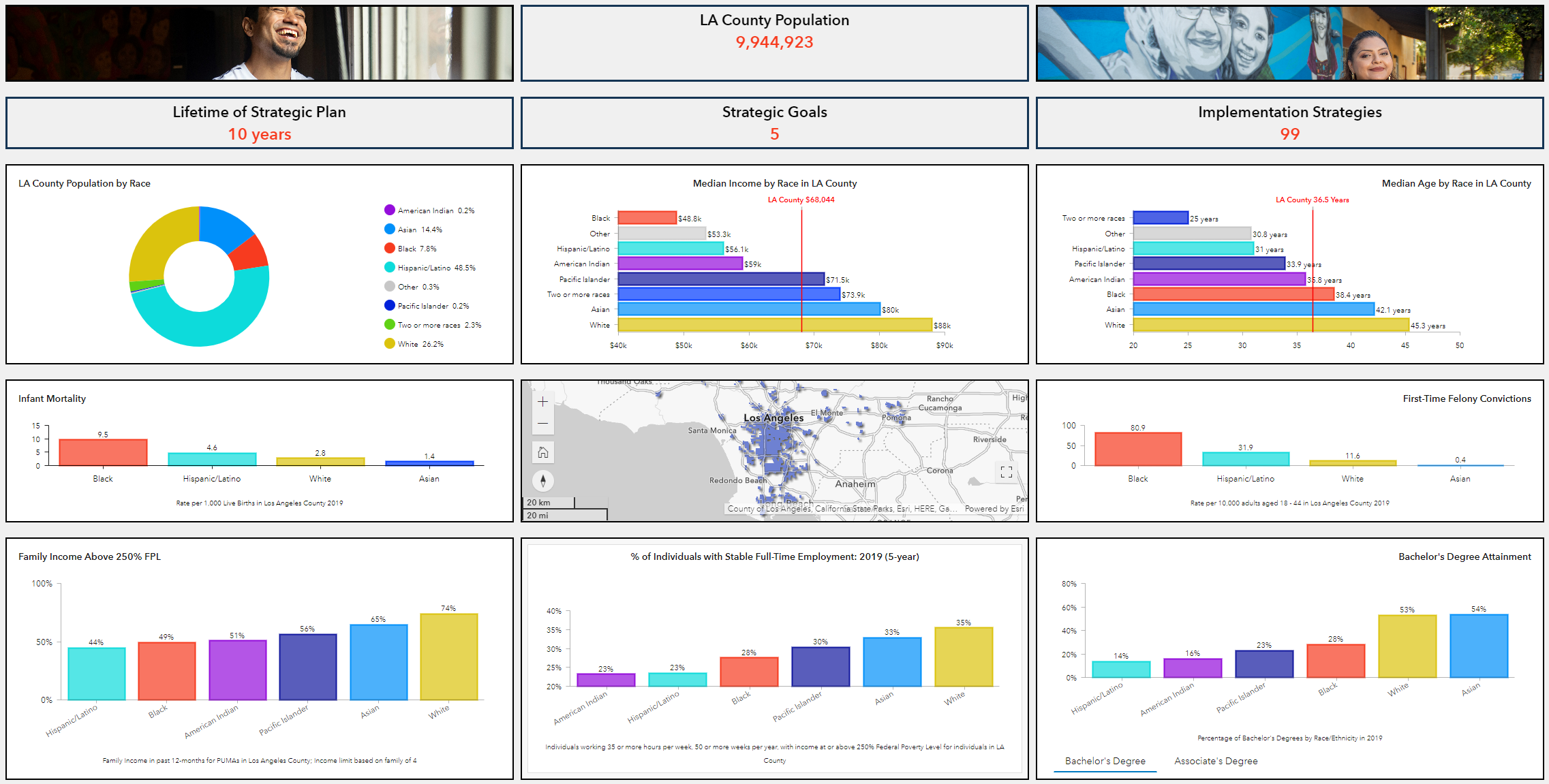Racial Equity
Strategic Plan
On July 21, 2020, the Los Angeles County Board of Supervisors (Board) unanimously adopted a motion to establish an Anti-Racism County Policy Agenda recognizing, affirming, and declaring that “racism is a matter of public health in the County of Los Angeles (County) and that racism against Black people has reached crisis proportions that result in large disparities in family stability, health and mental wellness, education, employment, economic development, public safety, criminal justice, and housing.” The Board issued several related directives, including the development of a strategic plan and underlying policy platform, and the establishment of an organizational unit—since created and called the Anti-Racism, Diversity, and Inclusion (ARDI) Initiative—within the Chief Executive Office (CEO) dedicated to implementing the plan.
The strategic plan articulates how LA County became inequitable, the historical factors (e.g., spatial and racial disparities and inequities) that helped produce racial disparities, and presents a vision for a new reality in the County. To help achieve this vision, this plan articulates a set of ten-year strategic goals, dozens of strategic initiatives, and an overview of activities that will move the County toward implementation.

Los Angeles County’s
Vision for Racial Equity
Los Angeles County will be a region where every resident can thrive regardless of the color of their skin through collaboration with County of Los Angeles government departments; County commissions, advisory bodies, and public agencies; the County’s 88 incorporated cities, 80 school districts, and 120 unincorporated areas; state and federal agencies, and any other jurisdictions; and community based organizations, philanthropy, and academic institutions. Using the Life Course Framework, the County will be able to support positive life trajectories and prevent negative life outcomes from the time a child is in the womb to the point of becoming an older adult.
Los Angeles County’s
10-Year Racial Equity Strategic Goals
Through a process of research, analysis, and deliberation, the County identified five strategic goals to be pursued over the next decade. “Strategic Goals” are defined as changes in population level outcomes that are to be achieved through multiple strategic initiatives. Learn more about the 10-year strategic goals in the full strategic plan.
STRATEGIC GOAL NO. 1:

Increase the Attainment of Postsecondary Credentials with Significant Labor Market Value
STRATEGIC GOAL NO. 2:

Reduce Adult First-Time Felony Convictions
STRATEGIC GOAL NO. 3:

Increase Stable Full-Time Employment Among Individual Adults with Incomes at or Above 250% Federal Poverty Level (FPL)
STRATEGIC GOAL NO. 4:

Increase the Percentage of Families with Incomes Above 250% Federal Poverty Level (FPL) for a Family of Four
STRATEGIC GOAL NO. 5:

Reduce Infant Mortality
Harnessing the Power of Data
In order to ensure that the County is making progress towards the strategic goals outlined above, ARDI will use data to (1) establish a baseline and monitor trends on all five strategic goals, (2) share information on and funding and other resources allocated to programs and initiatives tied to each goal (3) evaluate the effectiveness of programs and initiatives—both internal and external, (4) identify the areas in the County with the highest needs, (5) and track improvement over time.
This effort is part of our comprehensive accountability framework and will be combined with the County’s other data and GIS tools. As a public-facing tool aimed at ensuring rigor and transparency, the dashboard below will enable residents, community leaders, providers, policymakers, and other stakeholders to keep up with the County’s efforts and intended outcomes.
The Countywide
Guiding Equity Principles
Equity principles are generally values-based and incorporate and express ethical premises. They articulate how to do things right (effectively) and the right thing to do (express the values basis for action). They are also generally able to be evaluated, which means it is possible to document and judge whether the principle is being followed, and what results from following the principle. ARDI assembled feedback from internal stakeholder focus groups and discussions with County workgroup planning participants who helped define the County’s “Guiding Equity Principles,” which guided the strategic plan’s development and will continue to inform ongoing efforts to promote equity and anti-racism in the County. Guiding principles serve as “guardrails” or “pointers” for how the County should develop strategies and prioritize new initiatives with a timeline and metrics.

Creating an Enabling Environment
Drawing upon the Center for Community Investment’s Strengthening the Enabling Environment framework, ARDI acknowledges that both internal and external efforts are needed to create the conditions necessary to achieve the ten-year goals. These efforts may include policies, practices, procedures, processes, platforms, relationships, funding mechanisms, and capacities, among others, and must occur alongside the strategic initiatives to advance our progress towards shared goals. Below is a list of some initiatives that will help create the enabling environment needed to reach County’s five racial equity strategic goals.
- Increase organizational capacity through coordination and collaboration
- Ensure equity in County contracting and procurement
- Strengthen and diversify governance
- Offer education and training throughout the region
- Change hearts and minds
- Create a regional collaborative
- Host an annual summit
- Center community leadership and strengthen partnerships

Conclusion
ARDI will coordinate the implementation of the Racial Equity Strategic Plan through an Accountability Framework, in collaboration with department staff and leadership. The Accountability Framework is comprised of a suite of resources to implement changes through policy and practice shifts, measure progress through transparent data and evaluation, and expand County’s impact through alignment with existing efforts and strategic partnerships across sectors. ARDI will advance this multi-pronged accountability framework and monitor activities through a governance structure that will track the Plan’s progress and revisit its Strategic Goals and associated data every three years. This will allow ARDI to adjust the Plan as needed, recognizing that population needs will likely change and shift over time.
As the largest and most diverse county in America, Los Angeles County is poised to make racial equity a durable reality for its residents. Galvanized by the County Board of Supervisors to develop a comprehensive plan for realizing ambitious equity goals over the next decade, this document charts a course that has been reviewed and endorsed by thousands of residents, community organizations, and potential partners. Recognizing that racial inequity in our region is the product of decades of decisions by powerful public and private actors, the 99 strategies outlined in this plan seek to help bend the moral arc of history toward justice by collaborating with today’s private and public county, state and federal stakeholders to create a future where every resident can and does thrive. More concretely, this document signifies a commitment and roadmap for change that over the next decade will aim to significantly reduce disparate outcomes in the areas of physical and mental health, housing and housing stability, meaningful employment opportunities, language access, public safety and justice, and language access by race and ethnicity and other intersecting identities, including, but not limited to, gender, sexual orientation, immigration status, and disability.
Take Action: Bringing the Strategic Plan to Life!
We ALL can play a role in becoming an anti-racist LA County! The Racial Equity Strategic Plan presents a roadmap for change that cannot be done alone or in silos! All 9 million+ residents need to play a part in making this effort a reality! Ask yourself ‘How can I make a difference in reducing racial disproportionality around a strategic priority like infant mortality?’ Or, ‘How can I create an enabling environment at my workplace or amongst family and friends?’






